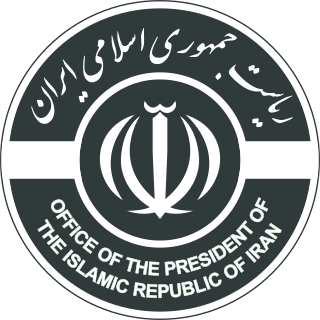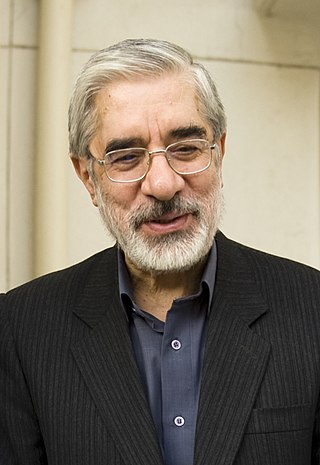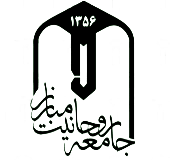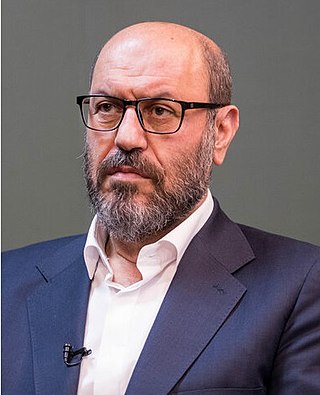
The president of Iran is the head of government of the Islamic Republic of Iran and the second highest-ranking official, after the Supreme Leader. The first election was held in 1980 and was won by Abulhassan Banisadr. Masoud Pezeshkian currently serves as the President Of Iran, after being elected in the 2024 Iranian presidential election and being officially endorsed by the Supreme Leader.

Seyyed Ali Hosseini Khamenei is an Iranian Twelver Shia marja' and politician who has served as the second supreme leader of Iran since 1989. He previously served as third president of Iran from 1981 to 1989. Khamenei's 34-year-long rule makes him the longest-serving head of state in the Middle East, as well as the second-longest-serving Iranian leader of the last century after Shah Mohammad Reza Pahlavi.

Ali Akbar Hashimi Bahramani Rafsanjani was an Iranian politician and writer who served as the fourth president of Iran from 1989 to 1997. One of the founding fathers of the Islamic Republic, Rafsanjani was the head of the Assembly of Experts from 2007 until 2011 when he decided not to nominate himself for the post. He was also the chairman of the Expediency Discernment Council.

Mir-Hossein Mousavi Khameneh is an Iranian reformist politician, artist and architect who served as the 45th and last Prime Minister of Iran from 1981 to 1989. He was a reformist candidate for the 2009 presidential election and eventually the leader of the opposition in the post-election unrest. Mousavi served as the president of the Iranian Academy of Arts until 2009, when conservative authorities removed him. Although Mousavi had always considered himself a reformist and believed in promoting change within the 1979 Revolution constitution, on 3 Feb 2023, in response to the violent suppression of Iranians by Ali Khamenei, the Supreme Leader of Iran, he announced opposition to the Islamic Republic constitution and asked for a widespread referendum to fully change the constitution and make a fundamental change in Iran's political system.

The prime minister of Iran was a political post that had existed in Iran (Persia) during much of the 20th century. It began in 1906 during the Qajar dynasty and into the start of the Pahlavi dynasty in 1923 and into the 1979 Iranian Revolution before being abolished in 1989.

Ali Akbar Velayati is an Iranian conservative politician and physician. He is currently a member of the Expediency Discernment Council. Velayati is a distinguished professor at Shahid Beheshti University of Medical Sciences, senior adviser to the Supreme Leader in international affairs and head of the board of founders and the board of trustees of the Islamic Azad University.
Presidential elections were held in Iran on 16 August 1985, and resulted in the re-election of the incumbent President Ali Khamenei.

The Islamic Republican Party was formed in 1979 to assist the Iranian Revolution and Ayatollah Khomeini in their goal to establish theocracy in Iran. It was disbanded in 1987 due to internal conflicts.

The Combatant Clergy Association is a politically active group in Iran, but not a political party in the traditional sense.

The Council of the Islamic Revolution was a group formed by Ayatollah Ruhollah Khomeini to manage the Iranian Revolution on 10 January 1979, shortly before he returned to Iran. "Over the next few months there issued from the council hundreds of rulings and laws, dealing with everything from bank nationalization to nurses' salaries." Its existence was kept a secret during the early, less secure time of the revolution, and its members and the exact nature of what the council did remained undisclosed to the public until early 1980. Some of the council's members like Motahhari, Taleqani, Bahonar, Beheshti, Qarani died during Iran–Iraq War or were assassinated by the MKO during the consolidation of the Iranian Revolution. Most of those who remained were put aside by the regime.

The Cabinet of Iran is a formal body composed of government officials, ministers, chosen and led by the President of Iran. Its composition must be approved by a vote in parliament. According to the Constitution of the Islamic Republic of Iran, a president may dismiss members of the cabinet, but must do so in writing, and new appointees must again be approved by parliament. The cabinet meets weekly on Saturdays in Tehran. There may be additional meetings as circumstances require. The president chairs them. The Supreme Leader of Iran Ali Khamenei has the power to dismiss cabinet members like ministers, vice presidents and presidents at any time, regardless of parliamentary decisions.
Premiership of Mir-Hossein Mousavi were the third and fourth government of Iran after the Iranian Revolution. At that time, Ali Khamenei was the president.

In August 1981, President Mohammad-Ali Rajai and Prime Minister Mohammad-Javad Bahonar were assassinated in an explosion. Ali Khamenei was then elected as the third president of Iran in the October 1981 Iranian presidential election. He put forward Ali Akbar Velayati as his prime minister, but the Iranian parliament did not give him the vote of confidence, and he was defeated with a vote of 80 to 74. Subsequently, Ali Khamenei, though he had strong disagreements with Mousavi, as a compromise with the left-leaning parliament, agreed to offer him, Mousavi, for the post of premier. On 28 October, the parliament approved Mousavi with a vote of 115 to 39. Mousavi became the 79th Prime Minister of Iran on 31 October 1981, and remained the prime minister of Iran until 3 August 1989, for eight years.

The parliamentary election for the 9th Islamic Consultative Assembly, or Majlis, were held in Iran on Friday, 2 March 2012 with a second round on 4 May 2012 in those 65 districts where no candidate received 25% or more of the votes cast. More than 5,000 candidates registered but more than a third were disqualified by the Guardian Council leaving about 3,400 candidates to run for the 290 seat representing the 31 provinces.

The supreme leader of Iran ), also referred to as Supreme Leader of the Islamic Revolution, but officially called the Supreme Leadership Authority, is the head of state and the highest political and religious authority of the Islamic Republic of Iran. The armed forces, judiciary, state radio and television, and other key government organizations such as the Guardian Council and Expediency Discernment Council are subject to the Supreme Leader. According to the constitution, the Supreme Leader delineates the general policies of the Islamic Republic, supervising the legislature, the judiciary, and the executive branches. The current lifetime officeholder, Seyyed Ali Hosseini Khameneh known as Ali Khamenei, has issued decrees and made the final decisions on the economy, the environment, foreign policy, education, national planning, and other aspects of governance in Iran. Khamenei also makes the final decisions on the amount of transparency in elections, and has dismissed and reinstated presidential cabinet appointees. The Supreme Leader is legally considered "inviolable", with Iranians being routinely punished for questioning or insulting him.

Hossein Dehghani Poudeh, commonly known as Hossein Dehghan, is an Iranian military officer and former IRGC Air Force officer with the rank of brigadier general. He is currently head of the Mostazafan Foundation since 2023.
The following lists events that happened during 1981 in Iran.

On 8 January 2017, Akbar Hashemi Rafsanjani, the fourth President of Iran and the country's Chairman of Expediency Discernment Council, died at the age of 82 after suffering a heart attack. He was transferred unconscious to a hospital in Tajrish, north Tehran. Attempts at cardiopulmonary resuscitation for more than an hour trying to revive him were unsuccessful and he died at 19:30 local time (UTC+3:30).

On 27 June 1981, in the Abuzar Mosque in Tehran, Iran, Ali Khamenei was injured after he gave a speech for prayers, with a bomb placed on the tape recorder in front of him exploded and his arm, vocal cords and lungs were damaged.












